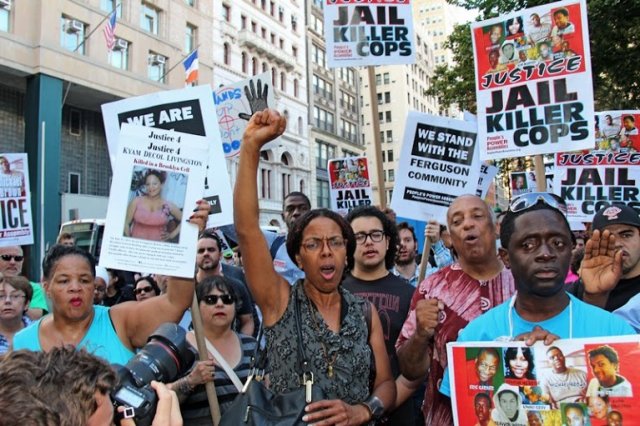
In the past few weeks, several large protest movements have rocked the Untied States political establishment and the elites it represents. These social explosions seem limited and separate, but they symbolise the growing contradictions of US society and the possibilities of mass struggles in the near future.
On one hand, there is the ongoing resistance to police violence and institutional racism in Ferguson, Missouri. In scenes that mirrored the stand-offs in the South during the civil rights movement, lines of heavily armed police have faced off against peaceful demonstrators in the streets of an otherwise quiet working-class community.
In Ferguson, which is 70% African American, there are only three African Americans on the police force. Black people account for over 90% of the stop and arrest rate in the town.
It is little wonder that the tragic murder of a young unarmed man by a police officer caused the sense of injustice that was harboured deep within the community to erupt into a wave of spontaneous uprisings.
In response, the local and then state police forces attacked peaceful protesters with military equipment, dispersing marchers with tear gas and shooting rubber-coated bullets into the crowd.
However, the extreme violence of the police was not enough to contain the uprising. In response, the governor of Missouri declared a state of emergency and announced a curfew, essentially imprisoning the townsfolk of Ferguson in a state of martial law. The local community became a police state.
Then, the state government, with possible prodding from the federal authorities, took an even more extreme step, calling the National Guard to put down the protest and “restore peace and order”.
The National Guard is a reserve section of the US Army and is staffed by volunteers. This was followed shortly after by the arrest of more than 50 demonstrators, most of whom were from the local area by the riot police.
The militarised police, baring automatic weapons and assault grade equipment invaded the town, pointing weapons at civilians, tear gassing reporters and smashing their equipment. Lines of police with rifles was reminiscent of the many cases of extreme violence used during the height of the civil rights and Black Power movements.
However, the determination of the people Ferguson was hardened by the shooting of another teen in St Louis, only a few miles from the scene of the killing of Brown. It seems, even when the eyes of the world are on them, the police cannot restrain themselves from taking Black lives.
In response to the ongoing struggle in Ferguson, solidarity demonstrations took place around the US, the largest of which was a mass demonstration in New York City.
This demonstration was also attacked by the police in a bid to shut down the protest.
Hundreds also marched in Oakland, an area famous as the place where the Black Panthers were formed in the 1960s to combat police violence.
Such displays of solidarity have been one of the main supports for the people of Ferguson as they continue their resistance to police violence. Messages of support have come in from as far as away as the occupied territories, with ordinary Palestinians taking to the Twittersphere to provide solidarity and advice for resisting police repression.
The Popular Front for the Liberation of Palestine released a statement in support of the uprising.
This symbolises the threat that Ferguson represents to the US establishment. This is not just about the shooting of one African American teenager. It is about centuries of deep-rooted exploitation and oppression of marginalised communities.
On the West Coast, we have seen another threat to US imperial power emerge, in the form of a powerful boycott movement against Israel, one of the US's closest allies.
In response to calls from Palestine to extend the campaign of boycotts, divestments and sanctions against the Israeli apartheid regime, US activists have blockaded several ports along the US West Coast to stop Israeli goods being unloaded.
The blockade of the Port of Oakland in California has stopped goods being unloaded from ships of Zim Integrated Shipping Services.
This comes as a response to calls by Palestinian trade unions to form an alliance between anti-imperialist activists and the US labour movement to raise the intensity of the BDS campaign.
Workers from the International Longshore and Warehouses Union and the Transport Workers Solidarity Committee have supported the picket and agreed to honour the boycott. The union has resisted attempts by pro-Israel organisation StandWithUs to swing union leaders towards a pro-Israeli viewpoint.
Activists in Long Beach, Seattle and the Canadian city of Vancouver all joined in the blockades, with protests and occupations against Israeli goods being unloaded.
Some activists have pointed out it is fitting that, with the port of Gaza having been blockaded by Israel for years, Israeli ships now face their own blockade.
These two seemingly unconnected social movements have shown that there is a radical undercurrent in US social life. Decades of imperial excess, racist violence and economic inequality have created a tinderbox.
A single spark can set off rebellions like the one we see right now in Ferguson, or more sustained campaigns, like the one hopefully underway on the US west coast.
Like Green Left Weekly on Facebook and follow us on Twitter.